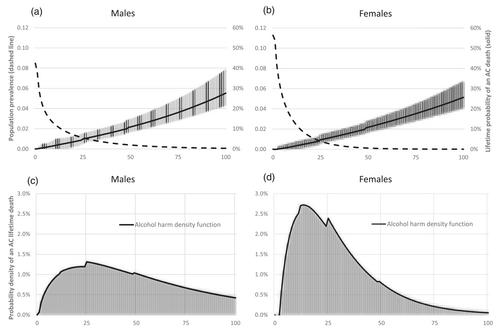Distributions of alcohol use and alcohol-caused death and disability in Canada: Defining alcohol harm density functions and new perspectives on the prevention paradox
Abstract
Aims
The aims of this study were to examine the distribution of alcohol use and to define ‘harm density functions’ representing distributions of alcohol-caused health harm in Canada, by sex, towards better understanding which groups of drinkers experience the highest aggregate harms.
Design
This was an epidemiological modeling study using survey and administrative data on alcohol exposure, death and disability and risk relationships from epidemiological meta-analyses.
Setting
This work took place in Canada, 2019.
Participants
Canadians aged 15 years or older participated.
Measurements
Measures included modeled life-time mean daily alcohol use in grams of pure alcohol (ethanol) per day, alcohol-caused deaths and alcohol-caused disability-adjusted life-years.
Findings
As a life-time average, more than half of Canadians aged 15+ (62.8% females, 46.9% males) use fewer than 10 g of pure alcohol per day (g/day). By volume, the top 10% of the population consume 45.9% of the total ethanol among males and 47.1% of the total ethanol among females. The remaining 90% of the population experience a slim majority of alcohol-caused deaths (males 55.3%, females 46.9%). Alcohol harm density functions compose the size of the using population and the risk experienced at each volume level to show that the population-level harm experienced is highest for males at 25 g/day and females at 13 g/day.
Conclusions
Almost 50% of alcohol use in Canada is concentrated among the highest 10% of drinkers, but more than half of the alcohol-caused deaths in Canada in 2019 were experienced by the bottom 90% of the population by average volume, providing evidence for the prevention paradox. New alcohol harm density functions provide insight into the aggregate health harm experienced across the mean alcohol use spectrum and may therefore be used to help determine where alcohol policies should be targeted for highest efficacy.


 求助内容:
求助内容: 应助结果提醒方式:
应助结果提醒方式:


